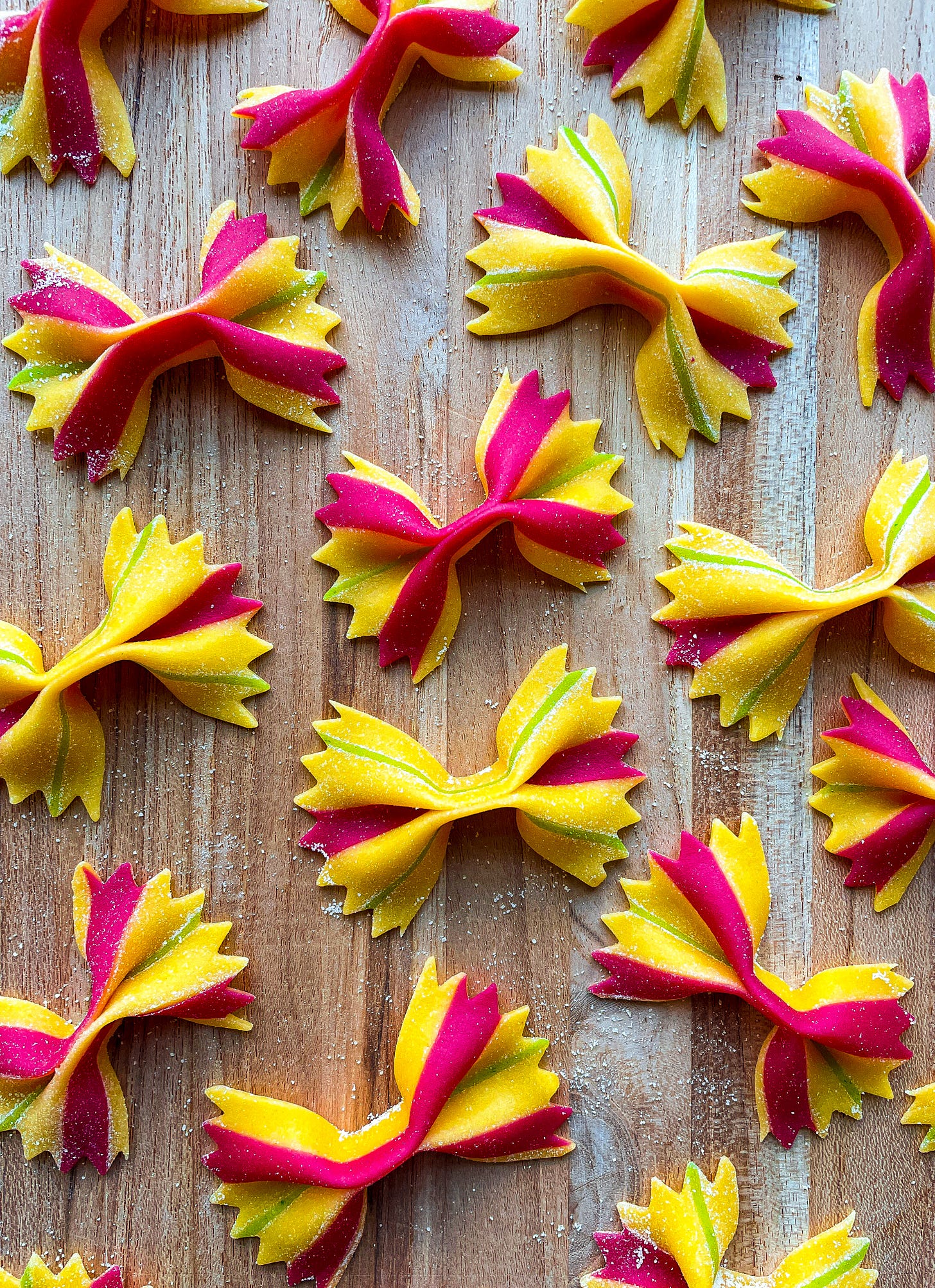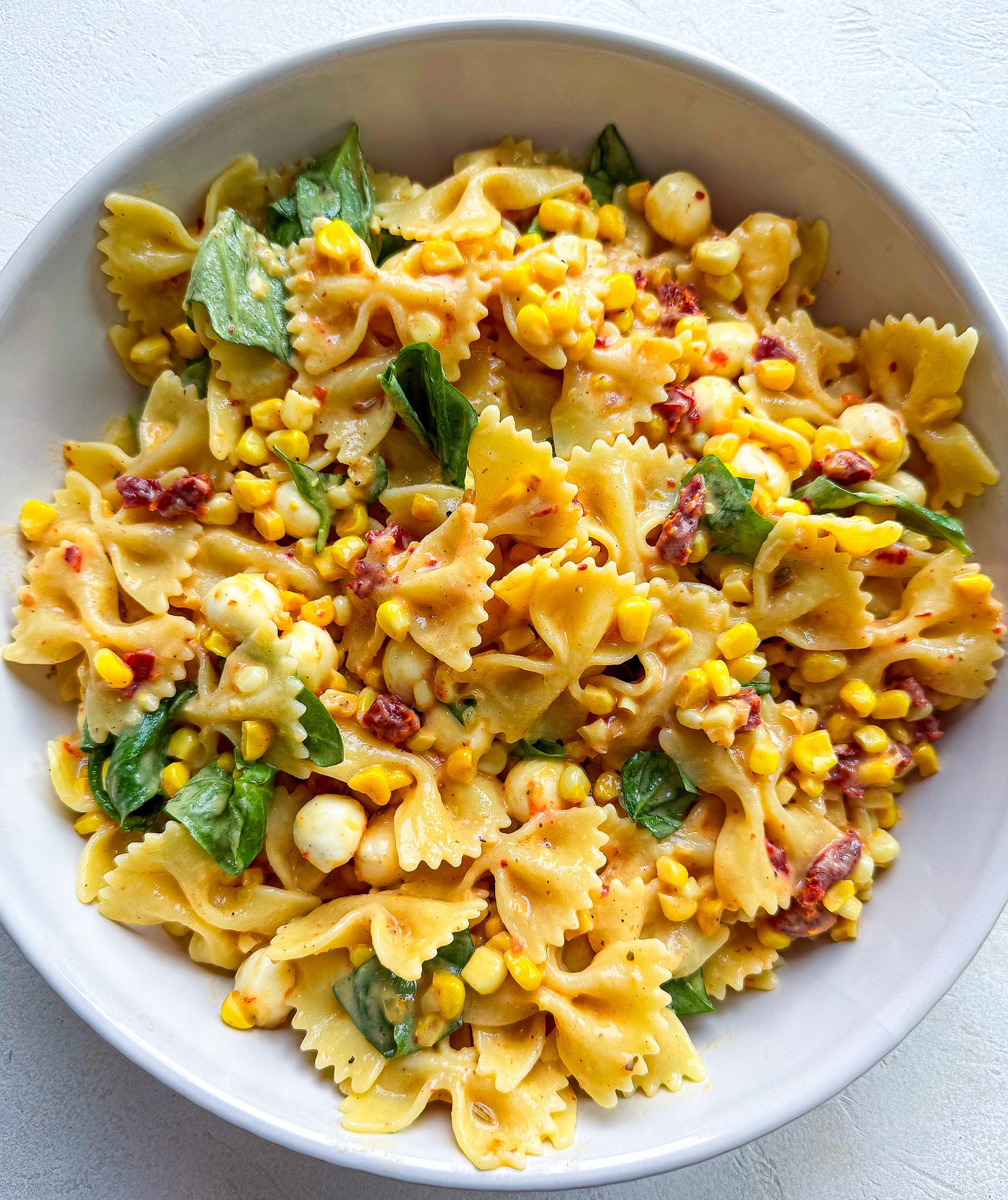Find me a child whose eyes don’t brighten at the sight of farfalle. Even at 35 I find it hard resist their playful noodle-wings, surely designed to zoom airplane-style into little mouths, but just as delightful for the older among us. A pasta that bursts with nostalgia, farfalle literally means “butterflies”—though I grew up with “bow ties”—and it’s a common canvas for summer dishes, particularly seafood sauces and pasta salads best enjoyed while lounging on the beach. Which is why I thought it would be the perfect pick for our July Pasta of the Month.
Although farfalle rose to fame in the 1970s, it’s actually one of Italy’s oldest pastas, dating back at least 400 years earlier, to the 16th century. Its origins lie in the north, particularly Lombardy and Emilia-Romagna, where it’s also known as strichetti, meaning “pinches.” Like so many pastas, farfalle were born of scraps and leftovers, in this case the offcuts of stuffed shapes like cappelletti—but so beloved did the little butterflies become that, in time, housewives would make extra dough just for them. In their birthplace, you’ll typically find farfalle prepared with peas and prosciutto, with cream and meat sauces (in Emilia-Romagna, with Bolognese or liver ragù), and with seafood, particularly salmon (fresh or smoked). In Lombardy, you’ll also see them sweetened with amaretti biscuits, butter, and sage in autumn, and tossed with arugula and calamari in summer.
Farfalle might have a historic pedigree, but their inherent whimsy has inspired plenty of modern variations. Today, they come in all shapes and sizes, from tiny farfalline to oversized farfalloni—the former, ideal for scooping up in broths and soups; the latter, magnets for ragùs and other rustic sauces. Some farfalle are made with alternative flours, others are decorated with ridges (farfalle rigate) and/or patterns, and still others are dyed all the colors of the rainbow. Indeed, farfalle tricolore—red, white, and green—have become a patriotic classic. All to say that there are few rules when it comes to farfalle, other than to enjoy them.
Now nearly all farfalle are factory-made. These are, colorful variations aside, produced with durum wheat flour (semolina) and water, giving the pasta its signature bite. When made by hand, farfalle and strichetti typically include eggs—this is, no doubt, because they originated from the trimmings of egg-based stuffed pastas. It also happens that, in my experience, it’s far easier to shape farfalle using a dough with eggs than one without, since the extra elasticity and fat makes for easier rolling and better structure. Still, I know many pasta-makers who fashion farfalle with durum wheat and water alone, so any dough will do the trick.
Considering the July heat and the eating traditions of this particular pasta, I’m going to deviate from our usual Pasta of the Month programming: Today’s recipe features dried, not fresh, farfalle. This is because I wanted to showcase this shape in one of its most popular preparations—as part of a pasta salad, or pasta fredda (“cold pasta”). And pasta fredda works best with dried pasta, which holds up to marinating and storage in a way that delicate fresh pasta does not. That said, I couldn’t possibly leave you without some handmade pasta inspiration, so at the bottom of this post, you’ll also find a video and step-by-step instructions for how to make farfalle from scratch, should you want to do so in the future.
As for the components of this particular pasta salad, I’ve embraced one of my favorite high-summer ingredients, sweet corn. You’ll rarely find sweet corn in Italian cuisine*, but if you do, it’s almost always in pasta fredda—and, in any event, if I’m going to break the rules, farfalle seems to be the pasta to do it with. As usual, I’ve let no part of the corn go to waste, and rounded out the ensemble with zingy sundried tomatoes, fresh pearls of mozzarella, and plenty of herbaceous basil. I’m calling it “farfalle fredda” and, in the creative spirit of both farfalle and pasta fredda, feel free to swap ingredients and make this recipe your own.
Finally, if you, like me, can’t get enough summer corn, I highly recommend trying this bucatini with corn, pepper & pecorino and this corn & mascarpone triangoli with pecorino basil butter. I’d also be remiss not to mention my somewhat extensive pasta salad recipe collection—all of which would make great 4th of July fare:
Wishing you all a lovely and relaxing weekend ahead, hopefully full of some delicious pasta!
*Many Italians vehemently despise sweet corn, the main reason being that in Europe it almost always comes in a can; nowhere will you find a freshly picked ear of corn, charred on the grill, and slathered in butter. Palermo is an exception, where boiled corn on the cob is a popular street food snack.
Farfalle Fredda with Summer Corn, Mozzarella & Sundried Tomatoes
Serves 4






